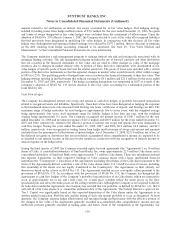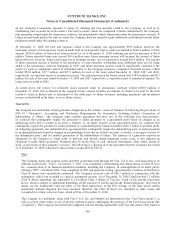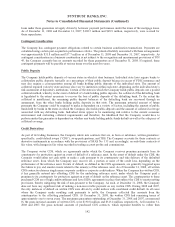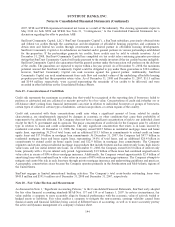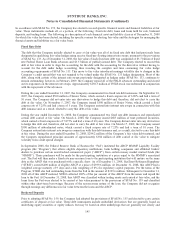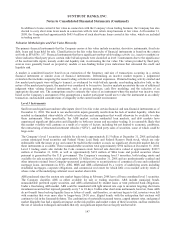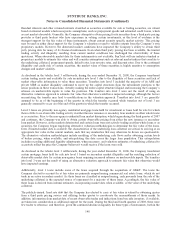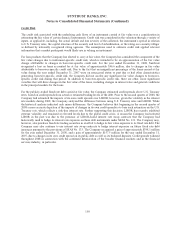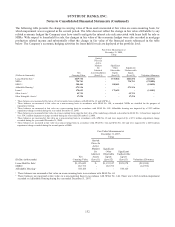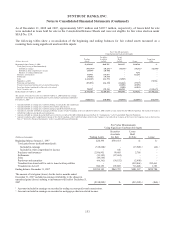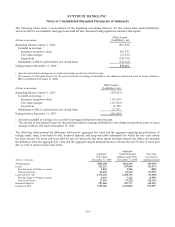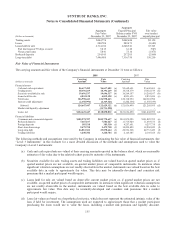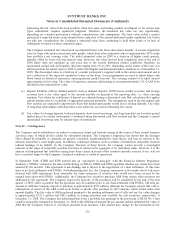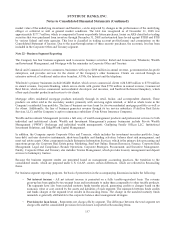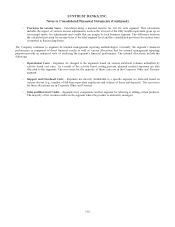SunTrust 2008 Annual Report Download - page 160
Download and view the complete annual report
Please find page 160 of the 2008 SunTrust annual report below. You can navigate through the pages in the report by either clicking on the pages listed below, or by using the keyword search tool below to find specific information within the annual report.SUNTRUST BANKS, INC.
Notes to Consolidated Financial Statements (Continued)
Residual interests and other retained interests classified as securities available for sale or trading securities, are valued
based on internal models which incorporate assumptions, such as prepayment speeds and estimated credit losses, which
are not market observable. Generally, the Company attempts to obtain pricing for its securities from a third party pricing
provider or third party brokers who have experience in valuing certain investments, as this level of evidence is the
strongest support for the fair value of these instruments, absent current security specific market activity. This pricing
may be used as either direct support for the Company’s valuation or used to validate outputs from the Company’s own
proprietary models. However, the distressed market conditions have impacted the Company’s ability to obtain third
party pricing data for many of its financial instruments. Even when third party pricing has been available, the limited
trading activity and illiquidity resulting from current market conditions has challenged the observability of these
quotations. When observable market data for these instruments is not available, SunTrust will use industry-standard or
proprietary models to estimate fair value and will consider assumptions such as relevant market indices that correlate to
the underlying collateral, prepayment speeds, default rates, loss severity rates, and discount rates. Due to the continued
illiquidity and credit risk of certain securities, the market value of these securities is highly sensitive to assumption
changes and market volatility.
As disclosed in the tabular level 3 rollforwards, during the year ended December 31, 2008, the Company transferred
certain trading assets and available for sale securities into level 3 due to the illiquidity of these securities and lack of
market observable information to value these securities. Transfers into level 3 included the majority of its ABS and
private MBS as market illiquidity continued to move up the capital structures from the subordinate positions to the
senior positions in these transactions, virtually making the entire capital structure illiquid and increasing the Company’s
reliance on unobservable inputs to value the positions. The transfers into level 3 were not the result of using an
alternative valuation approach to estimate fair value that otherwise would have impacted earnings, although the factors
necessitating the transfer may lead to modifications in the valuation approach. Transfers into level 3 are generally
assumed to be as of the beginning of the quarter in which the transfer occurred while transfers out of level 3 are
generally assumed to occur as of the end of the quarter in which the transfer occurred.
Level 3 loans are primarily non-agency residential mortgage loans held for investment or loans held for sale for which
there is little to no observable trading activity in either the new issuance or secondary loan markets as either whole loans
or as securities. Prior to the non-agency residential loan market disruption, which began during the third quarter of 2007
and continues, the Company was able to obtain certain observable pricing from either the new issuance or secondary
loan market. However, as the markets deteriorated and certain loans were not actively trading as either whole loans or as
securities, the Company began employing alternative valuation methodologies to determine the fair value of the loans.
Even if limited market data is available, the characteristics of the underlying loan collateral are critical to arriving at an
appropriate fair value in the current markets, such that any similarities that may otherwise be drawn are questionable.
The alternative valuation methodologies include modeling of the underlying cash flows and/or obtaining certain levels
of broker pricing, when available, and extrapolating this data across the larger loan population. This extrapolation
includes recording additional liquidity adjustments, when necessary, and valuation estimates of underlying collateral to
accurately reflect the price the Company believes it would receive if the loans were sold.
As disclosed in the tabular level 3 rollforwards, during the year ended December 31, 2008, the Company transferred
certain mortgage loans held for sale into level 3 based on secondary market illiquidity and the resulting reduction of
observable market data for certain non-agency loans requiring increased reliance on unobservable inputs. The transfers
into level 3 were not the result of using an alternative valuation approach to estimate fair value that otherwise would
have impacted earnings.
Additionally, level 3 loans include some of the loans acquired through the acquisition of GB&T. The loans the
Company elected to account for at fair value are primarily nonperforming commercial real estate loans, which do not
trade in an active secondary market. As these loans are classified as nonperforming, cash proceeds from the sale of the
underlying collateral is the expected source of repayment for a majority of these loans. Accordingly, the fair value of
these loans is derived from internal estimates, incorporating market data when available, of the value of the underlying
collateral.
The publicly-issued, fixed rate debt that the Company has elected to carry at fair value is valued by obtaining quotes
from a third party pricing service and utilizing broker quotes to corroborate the reasonableness of those marks. In
addition, information from market data of recent observable trades and indications from buy side investors, if available,
are taken into consideration as additional support for the mark. During the third and fourth quarters of 2008, there were
few trades to reference, and therefore, given the continued decline in liquidity for these types of instruments, both in the
148


